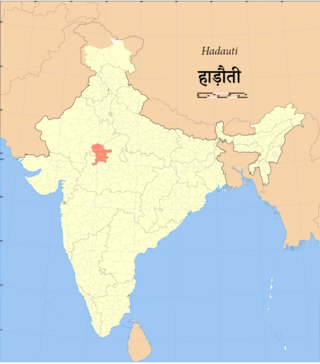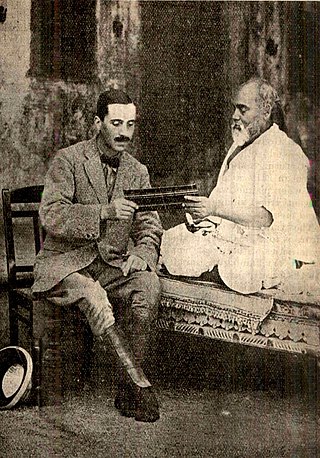
Modern Standard Hindi, commonly referred to as Hindi, is an Indo-Aryan language from the Indo-European language family that serves as the lingua franca of the Hindi Belt region encompassing parts of northwestern, central, eastern, and western India. Hindi is a standardised and Sanskritised register of the Hindustani language, which itself is based primarily on the Khariboli dialect of Delhi and neighbouring areas of North India. Hindi, written in the Devanagari script, is one of the two official languages of the Government of India, along with English. It is an official language in nine states and three union territories and an additional official language in three other states. Hindi is also one of the 22 scheduled languages of the Republic of India.

Hindustani is an Indo-Aryan language spoken in Deccan, Northern India and Pakistan, and used as a lingua franca in both countries. Hindustani is a pluricentric language with two standard registers, known as Hindi and Urdu. Thus, it is also called Hindi–Urdu. Colloquial registers of the language fall on a spectrum between these standards. In modern times, a third variety of Hindustani with significant English influences has also appeared which is sometimes called Hinglish or Urdish.

The Indo-Aryan languages are a branch of the Indo-Iranian languages in the Indo-European language family. As of the early 21st century, they have more than 800 million speakers, primarily concentrated in Bangladesh, India, Pakistan, Sri Lanka, Maldives and Nepal. Moreover, apart from the Indian subcontinent, large immigrant and expatriate Indo-Aryan–speaking communities live in Northwestern Europe, Western Asia, North America, the Caribbean, Southeast Africa, Polynesia and Australia, along with several million speakers of Romani languages primarily concentrated in Southeastern Europe. There are over 200 known Indo-Aryan languages.

Gujarati is an Indo-Aryan language native to the Indian state of Gujarat and spoken predominantly by the Gujarati people. Gujarati is descended from Old Gujarati. In India, it is one of the 22 scheduled languages of the Union. It is also the official language in the state of Gujarat, as well as an official language in the union territory of Dadra and Nagar Haveli and Daman and Diu. As of 2011, Gujarati is the 6th most widely spoken language in India by number of native speakers, spoken by 55.5 million speakers which amounts to about 4.5% of the total Indian population. It is the 26th most widely spoken language in the world by number of native speakers as of 2007.

Hadauti or Harauti (Hadoti) is an Indo-Aryan language of Rajasthani languages group spoken by approximately four million people in the Hadoti region of southeastern Rajasthan, India. Its speakers are concentrated in the districts of Kota, Baran, Bundi and Jhalawar in Rajasthan, as well as in neighbouring areas of Madhya Pradesh.

The Marwari or Marwadi are an Indian ethnic group that originate from the Marwar region of Rajasthan, India. Their language, also called Marwari, comes under the umbrella of Rajasthani languages, which is part of the Western Zone of Indo-Aryan languages.

The Hindi Belt, also known as the Hindi Heartland, is a linguistic region encompassing parts of northern, central, eastern, and western India where various Northern, Central, Eastern and Western Indo-Aryan languages are spoken, which in a broader sense is termed as Hindi languages, with Standard Hindi serving as the lingua franca of the region.

The Bhil languages are a group of Indo-Aryan languages spoken by around 10.4 million Bhils in western and central India as of 2011. They constitute the primary languages of the southern Aravalli Range in Rajasthan and the western Satpura Range in Madhya Pradesh, northwestern Maharashtra, and southern Gujarat. According to the 52nd report of the commissioner for linguistic minorities in India, Ministry of Minority Affairs, Bhili is the most commonly spoken language of the district of Dadra and Nagar Haveli constituting 40.42% of its total population. Bhili speakers are also significant in the states of Gujarat (4.75%), Madhya Pradesh (4.93%) and Rajasthan (4.60%).

Rajasthani languages are a branch of Western Indo-Aryan languages. It is spoken primarily in the state of Rajasthan and adjacent areas of Haryana, Gujarat and Madhya Pradesh in India. There are also speakers in the Pakistani provinces of Punjab and Sindh. Rajasthani is also spoken to a lesser extent in Nepal where it is spoken by 25,394 people according to the 2011 Census of Nepal.

Mewari is a dialect of the Rajasthani languages. It is spoken by about five million speakers in Rajsamand, Bhilwara, Udaipur, Chittorgarh and Pratapgarh districts of Rajasthan state and Mandsaur, Neemuch districts of Madhya Pradesh state of India.
Dhatki, also known as Dhatti, Thari, is a dialect continuum or cluster/series of smaller dialects all mixed of Sindhi and Rajasthani (Marwari) with varying proportions, the Indo-Aryan Languages of the Indo-European language family.

The Bagri (बागड़ी) is a dialect bridge between Haryanvi, Rajasthani, and Punjabi and takes its name from the Bagar tract region of Northwestern India in the states of Rajasthan, Punjab and Haryana. The speakers are mostly in India, with a minority of them in Bahawalpur and Bahwalnagar areas in modern day Pakistan.

Dhundhari (ढूंढाड़ी), also known as Jaipuri, is a Rajasthani language within the Indo-Aryan language family. It is spoken in the Dhundhar region of northeastern Rajasthan state, India. Dhundari-speaking people are found in four districts – Jaipur, Sawai Madhopur, Dausa, Tonk and some parts of Sikar, Karauli and Gangapur District.
The Sansi language, Sansiboli, or Bhilki, is a highly endangered Indo-Aryan language of the Central group. The language is spoken by the nomadic Sansi people.

Dingal, also known as Old Western Rajasthani, is an ancient Indian language written in Nagri script and having literature in prose as well as poetry. It is a language of very high tone and requires a specific style of speaking. Dingal was used in Rajasthan and adjoining areas including Gujarat, Kutch, Malwa, and Sindh. Most of Dingal literature is said to be composed by Charans. It was prominently used in composition of war poetry praising the martial exploits of Rajput and Charan war heroes.
Rajasthani literature is an tradition in Indian literature dating to the 2nd millennium, which includes literature written in the Rajasthani language. An early form of Rajasthani started developing in the 11th century from Saurseni Prakrit as Maru-Gurjar or Gurjar Apabhramsa. Early Rajasthani literature was usually written by Charans. Earlier Rajasthani was known as Charani or Dingal, which was close to Gujarati. Medieval Rajasthani literature was mostly heroic poetry mentioning the great kings and fighters of Rajasthan. Rabindra Nath Tagore, a Bengali polymath, once said, "The heroic sentiment which is the essence of every song and couplet of a Rajasthani is peculiar emotion of its own of which, however, the whole country may be proud". It is generally agreed that modern Rajasthani literature began with the works of Suryamal Misran, including the Vansa Bhaskara and the Vir Satsai. The Vansa Bhaskara contains accounts of the Rajput princes who ruled in what was then Rajputana, during the lifetime of the poet (1872–1952). The Vir Satsai is a collection of hundreds of couplets.

Luigi Pio Tessitori was an Italian Indologist and linguist.
Ahirwati is an Indo-Aryan dialect of India. It is spoken within the Ahirwal region located to the south-west of the capital Delhi. It belongs to the Rajasthani language group and is commonly taken to be a dialect of Mewati, but in many respects it is intermediate with the neighbouring varieties of Bangru and Bagri, and is especially close to Shekhawati.

The following outline is provided as an overview of and topical guide to Rajasthan:

Old Western Rājasthāni is the ancestor of the modern Gujarati and Rajasthani languages which developed from Sanskrit and the Prakrit Apabhraṃśas, and was spoken around 8-14th centuries in Western India. The literary form of Old Western Rājasthāni, the Dingala language was in use as early as the 12th century. While the spoken Old Western Rajasthani gave way to medieval forms of Rajasthani and Gujarati, it flourished in its literary form as Dingala till the 19th century.

















